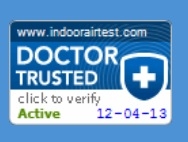News
Health Affects of Molds and Bacteria in Modern Buildings
Toxicological evidence obtained in vivo and in vitro supports these findings showing the occurrence of diverse inflammatory and toxic responses after exposure to microorganism including their spores, metabolites and components isolated from damp buildings.
Tampa, FL -- In today’s modern buildings microorganisms present a distinct challenge for those who manage and occupy them and are key components of bio-aero-pollution in today’s buildings.
Studies have shown that the growth of microorganisms such as bacteria and fungi in and around a building serves as a source of indoor bio-pollutant. World Health Organization (WHO Guidelines for Indoor Air Quality, 2009) concluded that the most important effect is increased prevalence of respiratory symptoms, allergies and asthma, as well as perturbation of the immunological systems. According to the report building dampness (supporting factor for microbial growth in buildings) varies widely from country to country and climatic zone. Dampness is estimated to affect 10-50% of all indoor environments in North America, Australia, Europe, India, and Japan.
It is often difficult to ascertain the exact dose/affect relationship by which the indoor air microbes may cause adverse health effects. However, irritation/toxic reactions, allergy or hypersensitivity, beside systemic infections are common upon the exposure of indoor microorganisms.
Toxicological evidence obtained in vivo and in vitro supports these findings showing the occurrence of diverse inflammatory and toxic responses after exposure to microorganism including their spores, metabolites and components isolated from damp buildings.
Dr. Janvier Gasana, MD, professor at Florida International University (FIU), Robert Stempel College of Public Health, Environmental and Occupational Health and Chair of Florida Children’s Environmental Health stated “medically there is a direct association between poor indoor air quality in both homes and buildings and an increase in prevalence of asthma, emergency room visits and allergy-type symptoms.”
These organisms include but are not limited to: Aspergillus, Alternaria, Blastomyces, Candida, Cladosporium, Cryptococcus, Emmonsia, Ganoderma, Histoplasma, Microsporum, Mucor, Penicillium, Rhizopous, Stachybotris and Trichophyton etc. are example of some common molds reported from indoor environments that cause a number of health and hygiene problems.
Common indoor environmental bacteria such as Acetobacter, Actinomyces, Alcaligenes, Bacillus, Brucella, Citrobacter, Clostridum, Coliform, Escherichia, Entrobacter group, Francisella, Klebsiella, Pseudomonas, Salmonella, Staphylococcus, Sterptococcus, Mycobacterium, Legionella, Listeria, Yersinia etc. are all capable of adversely effecting health and hygiene. Relatively little is known about the viruses in indoor air; however, viruses like influenza may also spread in the indoor environment through ventilation system.
Microorganisms naturally occur and play an important position in the earth’s ecological system. Therefore, it is not possible to eliminate these metabolites in their entirety. The most important aspect is to facilitate the nature and extent of these organisms in order to maintain good indoor air quality (IAQ). To understand the complexity involved (as mentioned above), it is essential to identify the causal factors such as physical, chemical, biological, and environmental. Some important physical factors are light, heat, dampness, chemical factors includes nutrition such as availability of organic or in-organic materials, biological factors includes naturally occurring microorganisms and their growth potential etc., and environmental factor such as moisture, relative humidity, and temperature are noticed as significant. The adverse effects given by these microorganisms can be managed and prevented depending on the results of the aforesaid information.
It is not practical to design a universal guideline fit for all in terms of exposure and health because immunity varies greatly from individual to individual. EDLab at Pure Air Control Services performed a 10 year study analyzing more than 7,000 buildings and over 25,000 environmental samples that were collected across the United States and abroad. The building type included both commercial and residential. The majority of samples analyzed were tested positive for bacteria and fungi.
In this study the average (normal baseline) concentration of air-borne cultureable (viable) bacteria was 175 CFU (Colony Forming Unit)/m3, and the fungal concentration in ambient air was recorded at 350 CFU/m3. The average concentration of non viable air-borne mold/fungal elements was estimated at approximately 1,000 cts (counts)/ m3. These baseline numbers are used as a reliable indicator for an expected average disseminated microbial (bacteria/fungi only) concentrations in today’s modern buildings.
The Environmental Diagnostics Laboratory (EDLab) at Pure Air Control Services (an AIHA accredited lab and CDC ELITE lab) analyzes a wide array of environmental microorganisms (bacteria and fungi) including organisms such as Staphylococcus aureus and Legionella pneumophila. EDLab scientists identify microorganisms by using various lab techniques. Some common analysis performed by EDLab to identify microbial conditions include Bio-Scan and Spore Trap analysis, mycological culturable analysis of air/bulk/surface/swab/liquid environmental samples among many others. The type of sampling and analysis performed is determined by project specifications project requirements or individual needs.
For additional information you can contact Dr. Rajiv Sahay, Director, EDLab, Pure Air Control Services 1-800-422-7873 ext 303 or visit the web site at www.pureaircontrols.com.
To discuss a more comprehensive environmental assessment of your building or home call the credentialed professional indoor environmental consultants at Pure Air Control Services-Building Sciences team at 800-422-7873, ext. 802.
About Pure Air Control Services:
Alan Wozniak founded Pure Air Control Services, Inc. in 1984 as a small mechanical contracting firm. Today, the firm sets the industry standard for indoor environmental quality diagnosis and remediation.
Pure Air Control Services nationally performed IAQ services include: Building Sciences Evaluation; Building Health Check; EDLab an AIHA accredited Environmental Microbiology Laboratory; Environmental Project Management; and HVAC System Cleaning & Mold Remediation Services, among other indoor environmental services.
The company’s expanding client roster includes the FAA, Walt Disney World, Northrup Gruman, General Services Administration (GSA); Allstate Insurance; USPS, CBRE, Carrier Air Conditioning; NAVFAC, DOT, USACE, US Army, and many other Fortune 500 companies, school boards, and city, state, and county governments, making Pure Air Control Services the reliable industry leader.
For more information on Pure Air Control Services, Inc. please contact Alan Wozniak or Cy Garner at (800) 422-7873 ext 802 or 804 respectively, or visit www.pureaircontrols.com.

More News

IAQ Test Kits (DIY), PURE-Steam Coil Cleaning and PURE-Decon Room Treatment Showcased at the Annual FRACCA Conference
This annual event provides an opportunity for licensed contractors throughout the State of Florida to obtain all 14 state-required hours of continuing education over the course of the two-day event.
Released On: 3/8/2014
Views: 4360

Free Legionella Webinar: Detection & Identification Workshop
Although this type of bacteria was around before1976, more illness from Legionnaires' disease is being detected now. Due to consumer awareness, added research and technological advances in healthcare Legionnaires disease identification is becomi ...
Released On: 3/4/2014
Views: 4216

Why Some High-Performance Buildings Are Failing?
Performance of a building depends on its structured integrity, preventive maintenance, as well as periodical monitoring of the environmental conditions essential for its functionality.
Released On: 2/19/2014
Views: 4247

Legionnaire’s – What You Should Know About The Potential Deadly Bacteria
According to Building Operating Management magazine, expert Victor Yu, MD, Professor of Medicine, University of Pittsburgh; Chief, Infectious Disease Section, VA Medical Center, Pittsburgh, PA, disclosed that “Up to 70% of all buildings greater t ...
Released On: 2/18/2014
Views: 3806

Managing of Indoor Environments: Problems and Solutions - IEQ WEBINAR
Released On: 1/22/2014
Views: 3703

Save Energy and Improve Indoor Air Quality (IAQ) with PURE-Steam Deep Coil Cleaning
High efficiency coils are extremely susceptible to blockage from dust accumulation because once lodged deeply within the fins bacteria and mold may initiate growth, which not only compounds the blockage problems but also gives rise to excessive o ...
Released On: 1/8/2014
Views: 6479

January is National Radon Action Month
Exposure to radon is the second leading cause of lung cancer after smoking. Radon is an odorless, tasteless and invisible gas produced by the decay of naturally occurring uranium in soil and water.
Released On: 1/8/2014
Views: 4138

Why indoor air quality is important to all of us?
World Health Organization (WHO Guidelines for Indoor Air Quality, 2009) concluded that the most important effect is increased prevalence of respiratory symptoms, allergies and asthma, as well as perturbation of the immunological systems
Released On: 12/31/2013
Views: 4195

Pure Air Control Services Launches New Interactive Website
The website is a true indoor environmental resource for the private and public sector including consumers, educational facilities e.g. schools, universities, along with city, county state and federal governments, healthcare and the public sector.
Released On: 12/20/2013
Views: 3192

Pure Air Control Services Awarded Certification from Doctor Trusted
“We are very proud to have been given the opportunity to display that we are a Doctor Trusted recipient. We will continue as always to help provide our customers with a great products and services,” stated Dr. Rajiv Sahay, environmental analytica ...
Released On: 12/11/2013
Views: 4139

IndoorAirTest.com Receives Seal of Approval by Doctor Trusted
IndoorAirtest.com is very proud to have a Doctor Trusted seal of approval displayed on our website, giving our customers more confidence when shopping with us.
Released On: 12/4/2013
Views: 4565

PURE-Decon/Sanosil, Reduces Sick Days Caused by Infection
Released On: 10/2/2013
Views: 3492

Controlling Asthma & Allergy Triggers Through Source Identification
The assessment of allergens in a house dust sample is an essential step for allergen-avoidance and provides information essential for allergen-reducing measures, in addition to managing the indoor environment from a health and hygiene point of view
Released On: 9/18/2013
Views: 5584

Hospitals Get a “Clean Bill of Health” with Innovative IAQ/Energy Solutions
Healthcare-associated infections (HAIs) are infections that patients acquire during the course of receiving healthcare treatment for other conditions.
Released On: 7/31/2013
Views: 4613

How Safe is Formaldehyde in our Buildings and Homes?
Released On: 7/17/2013
Views: 4884

Commercial Energy Solutions Seminar July 26, 2013
Released On: 7/11/2013
Views: 4940

Health Risks Associated With Indoor Microbes
Some common and frequently reported microbes of the indoor environment include, but are not limited to, viruses, bacteria, mycoplasma, mold (fungi), yeast, protozoa, etc.
Released On: 6/26/2013
Views: 6095

Aspergillosis: A Cause for Indoor Concerns?
In indoor environments, this fungus can be transported from outside or may propagate on building materials such as cellulose rich sheet rocks, etc. and can generally be isolated from floors, carpets, mattress dust, Heating Ventilation Air Conditi ...
Released On: 6/19/2013
Views: 10794

Map
Pure Air Control, Services, Inc.
Get DirectionsPure Air Control, Services, Inc.
-
4911 Creekside Drive
Clearwater, Florida 33760
United States - 1 (800) 422-7873


